Camping In Bakota
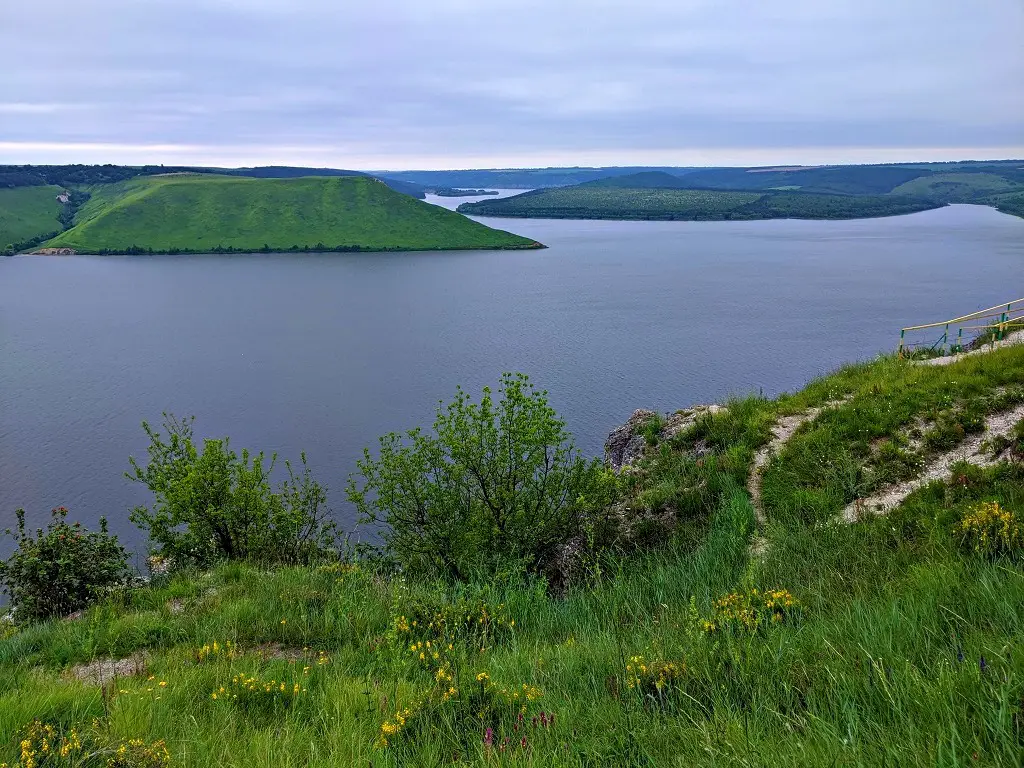
Due to the current Corona virus and not being able to fly around the world we decided to spend our summer traveling within Ukraine. The first location we chose was hiking in the Ukrainian Carpathians and white water rafting in Vorokhta. This trip we decided to take it easy and go camping in Bakota.
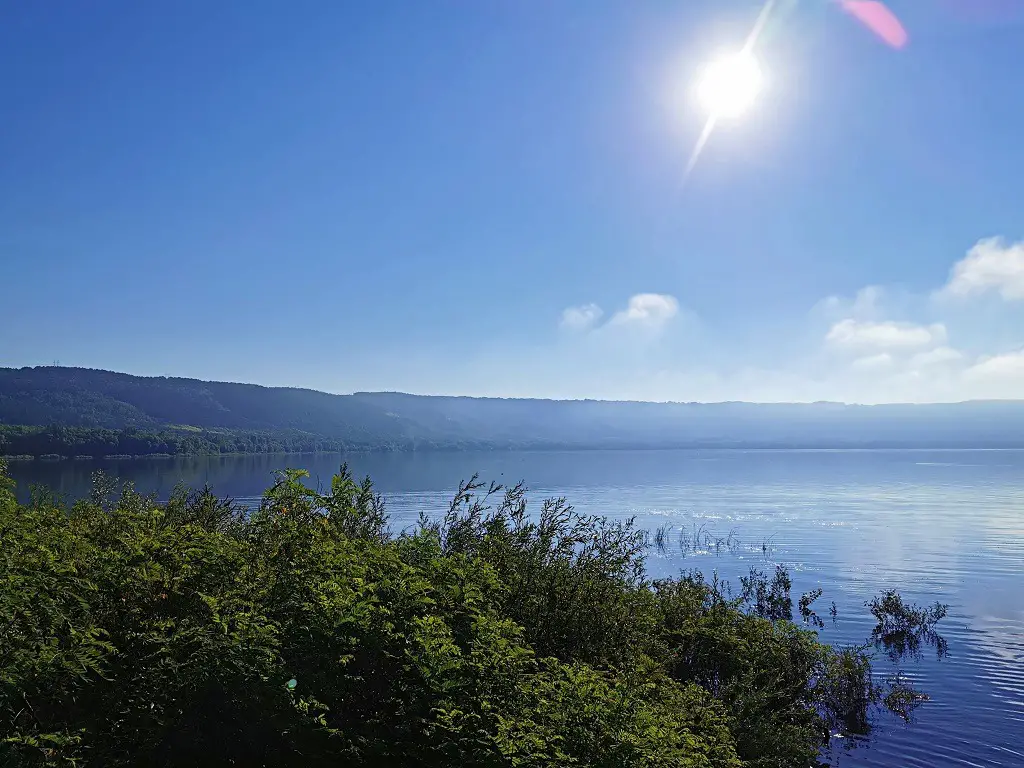
Maybe you have heard something about the Ukrainian Carpathians or Hoverla (the tallest mountain in Ukraine) before, but I am 100% sure you have never heard about Bakota (unless you are Ukrainian and reading my blog in English because truth be told, there’s not much info in Ukrainian to begin with).
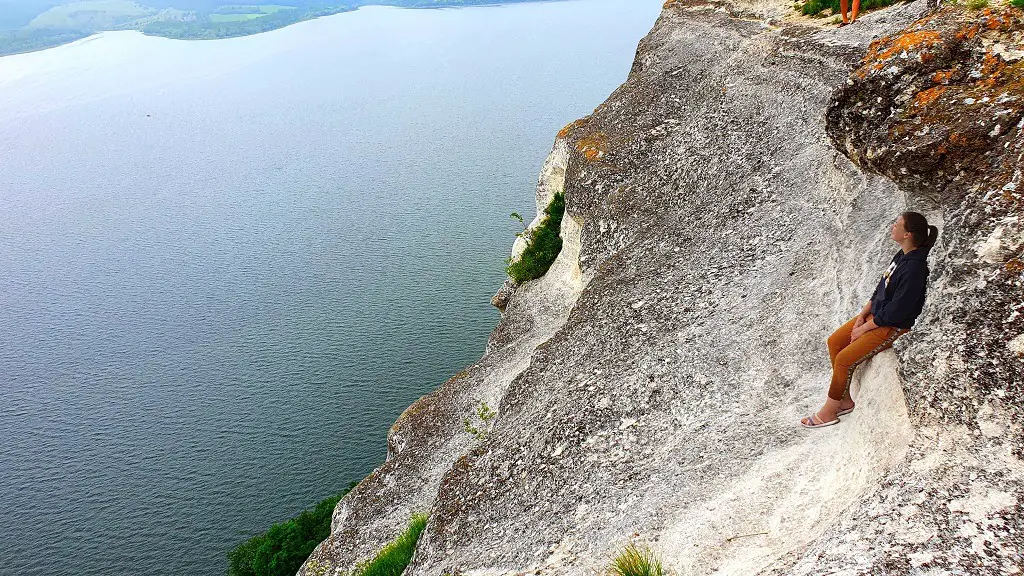
Bakota is located in the national park “Podilski Tovtry” not far from the Romanian border and Kamenets-Podilskyi city and it is a part of the Dniester river.
Table Of Contents (Camping In Bakota):
- History of Bakota
- How To Get To Bakota
- How To Get To The Cave Monastery and the White Rock
- How To Get To The Camping Site
- Camping In Bakota
- What To Bring For Camping In Bakota
History of Bakota
Bakota has a long, interesting, and dramatic history. From being the capital city of the Ponyzia region to the bottom of a water reservoir.
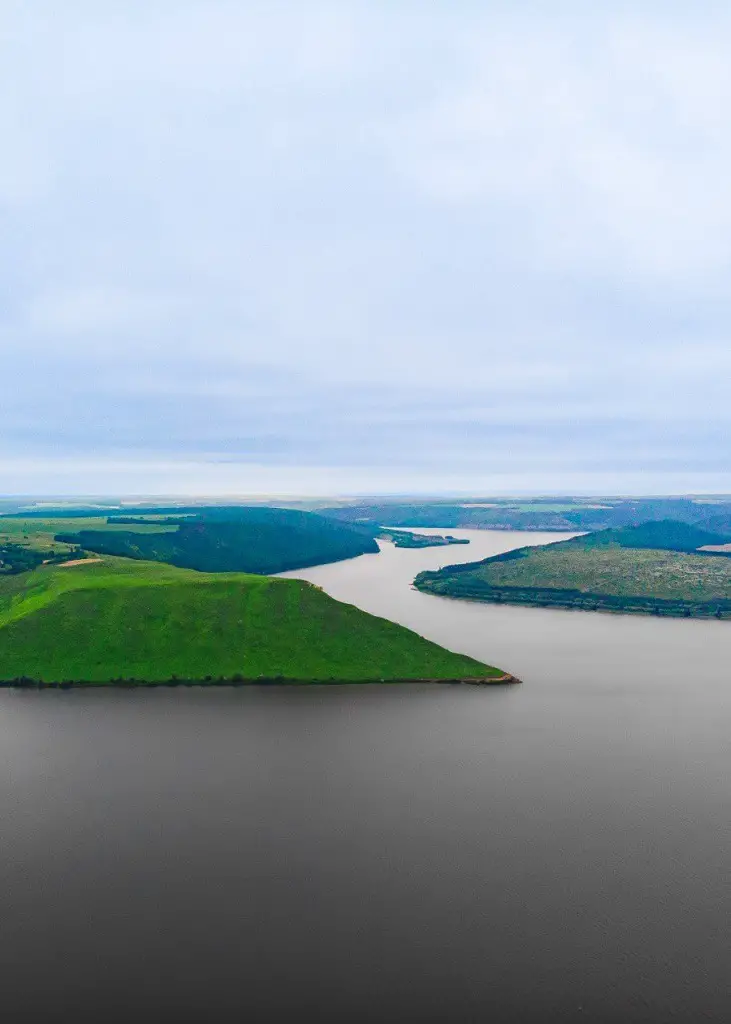
No one actually knows when Bakota was founded, but the first mention of it was in documents from 1240 as a big and important city with a quite big population for that period. In 1362 in another document mentioned a cave monastery that exists in the area. The cave monastery allegedly was founded by the same person who founded the famous Kyiv Pechersk Monastery on the right bank of Dnipro river in Kyiv.
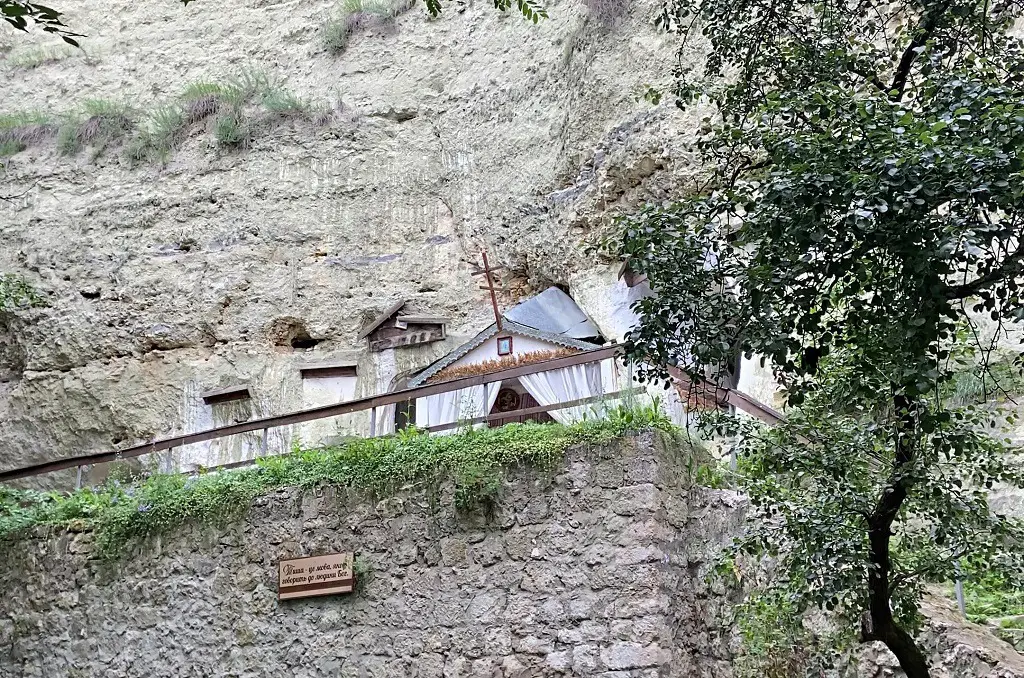
The story goes that in the 15th century Bakota was an important and big city and at that time people tried to get their independence from the Polish invaders. Unfortunately, that didn’t go well. The Polish response was brutal and many people were killed, farms were destroyed, and houses and Bakota castle were burned down. After this destruction the city never restored itself and has become a small village that lays next to the Dniester river.
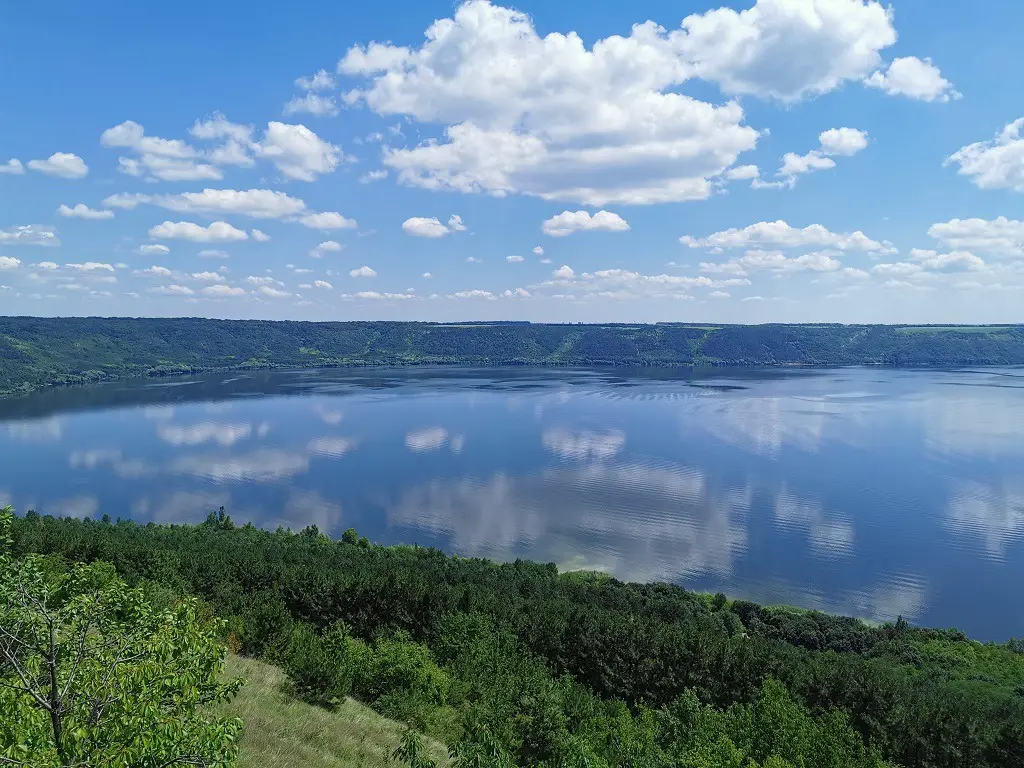
The story of this once great city ended in 1981 when the Dniester hydroelectric power station construction was being built. The people were relocated to a place not too far away and the village itself was submerged.
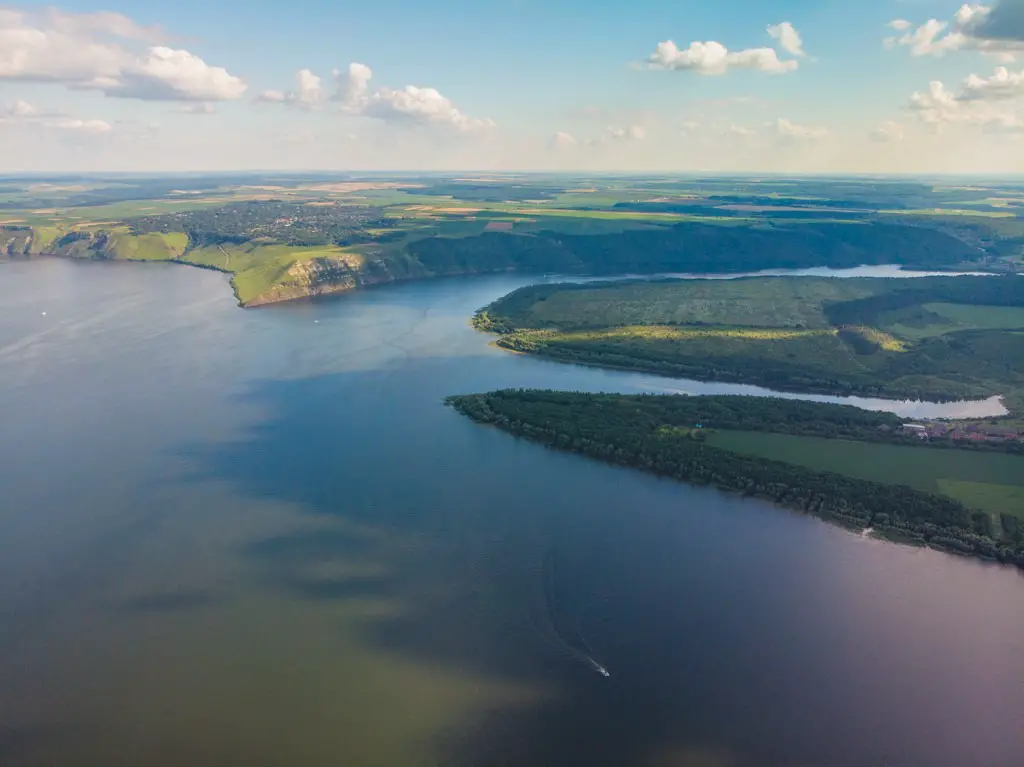
As a result of this submersion the White mountains where the cave monastery was founded collapsed and almost all the caves with murals and frescoes were ruined. Only one cliff with a few caves was preserved.
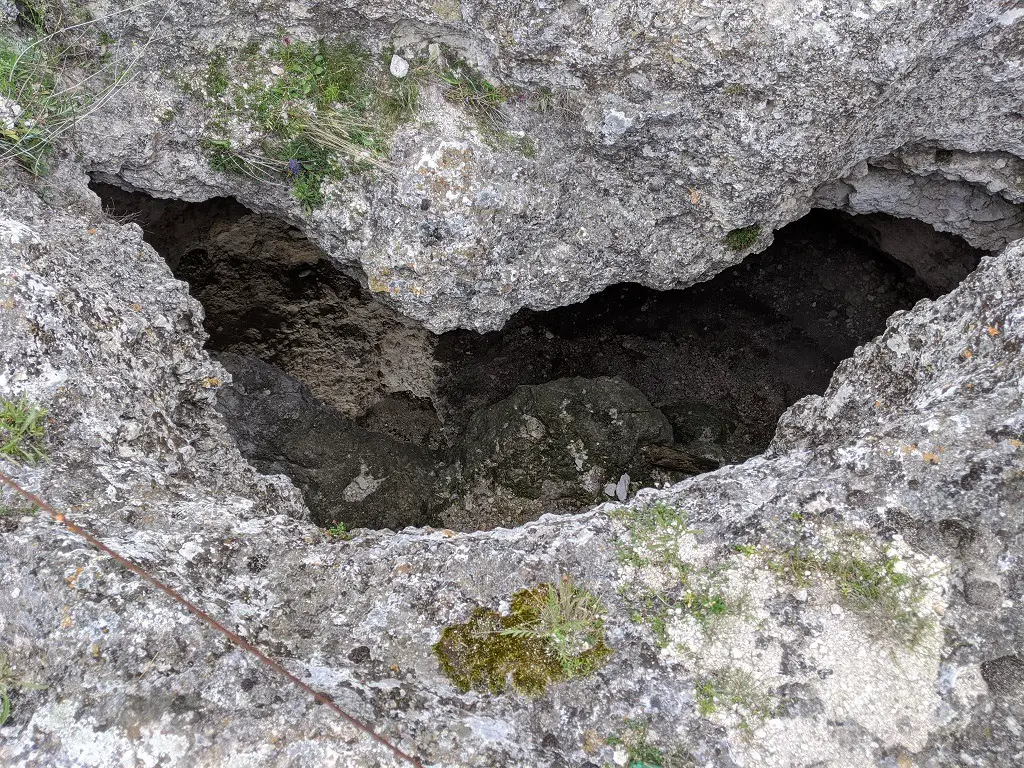
Today Bakota has become a camping site and one of the most beautiful spots along the Dniester river.
How To Get To Bakota
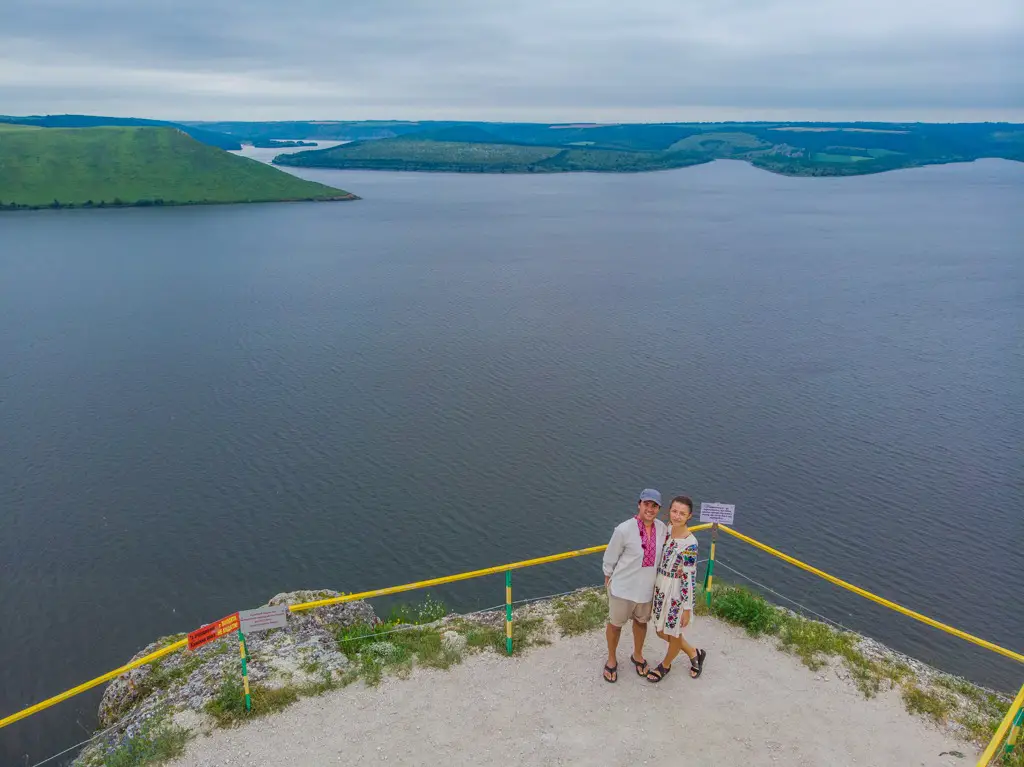
Bakota lays in the South West of Ukraine and it is quite difficult to get there on your own. Why is that? First of all there is very little information about it. Second, there not a lot of public transportation in the area. And third, many of the roads are in terrible condition.
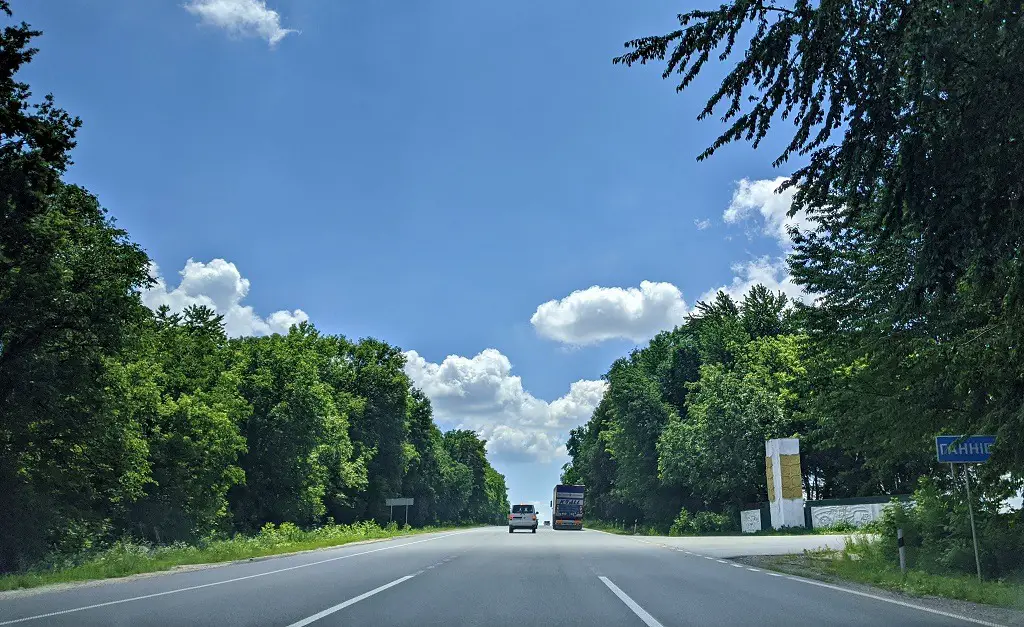
Before going to Bakota my friends and I tried to find all the information in Ukrainian or Russian that is available, but even that didn’t give us all the knowledge we needed. So here is everything you need to now about Bakota and how to visit it.
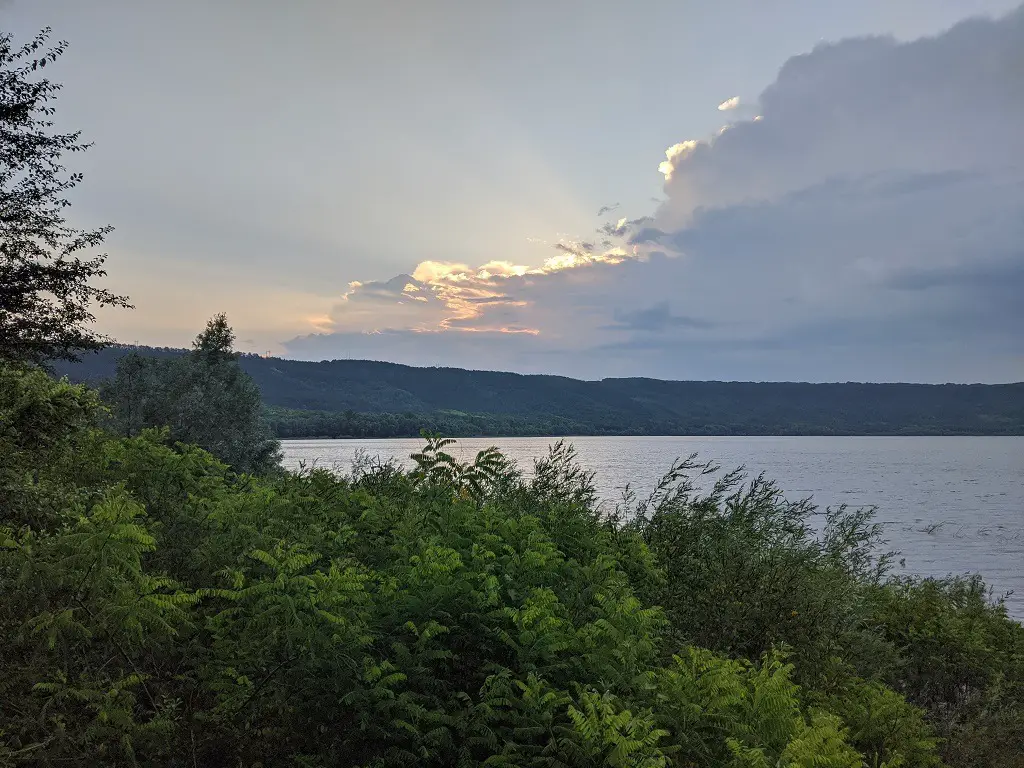
To get to Bakota on your own I suggest renting a car, public transportation is not the best in this area and driving yourself seems like the most convenient way to travel.
To get to Bakota it is easiest if you depart from Kamenets-Podilskyi. Kamenets-Podilskyi has an old center where you can visit one of the largest castles in Ukraine. So, if you have time, I advise you to visit the city center of Kamenets-Podilskyi. Of course we drove about 5 hours from my hometown, but we’ve all been to Kamenets-Podilskyi before and just wanted to go camping.
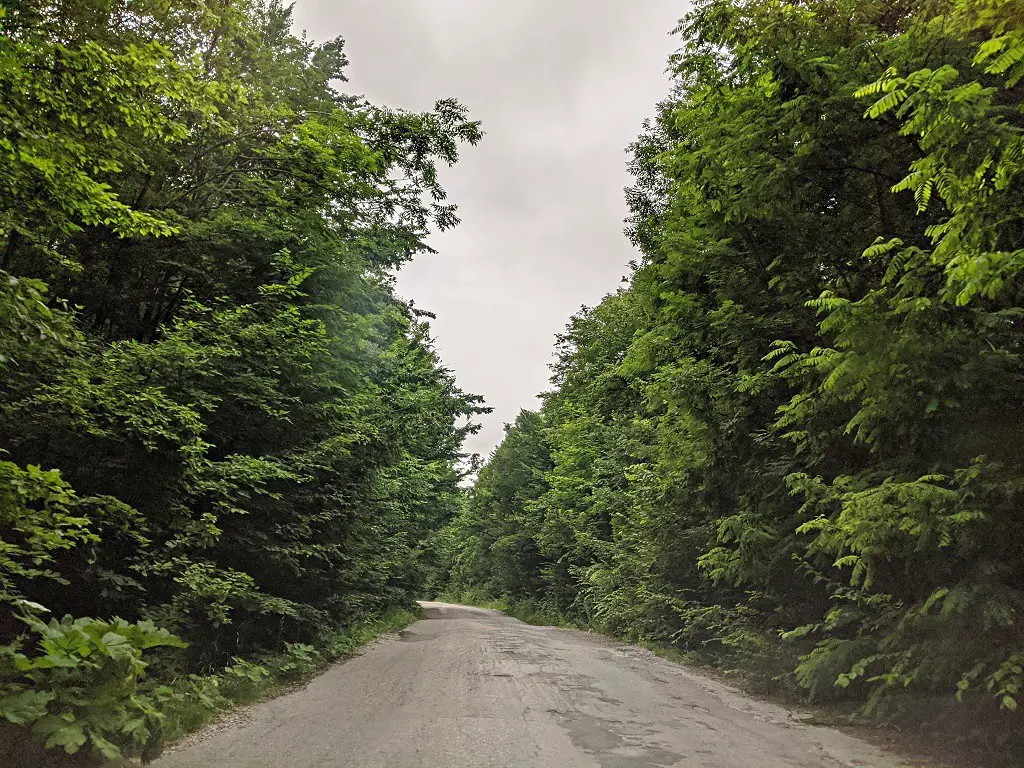
There are two spots that you would want to visit along Bakota. The first one is the White Rock (mountain) with the cave monastery and the second one is the camp grounds if you want to camp there for a few days.
How To Get To The Cave Monastery and the White Rock
To get to both locations first of all you need to get from Kamenets-Podilskyi (or wherever you are driving from) to a small village called Hrushka. From this village you will be able to get to both sites. The cave monastery and the White Rock are located right behind Hrushka village. It will take you just 15 minutes by a car from the village. On the way to the remains of the cave monastery there are some signs that would lead you to the top of White rock.
From the cliff’s edge there is a fantastic view of the whole Bakota. The most spectacular view is from this place so do not skip this location! To get to the cave monastery you will have to take stairs down the hill that are located not far from the viewpoint on the top of White Rock.
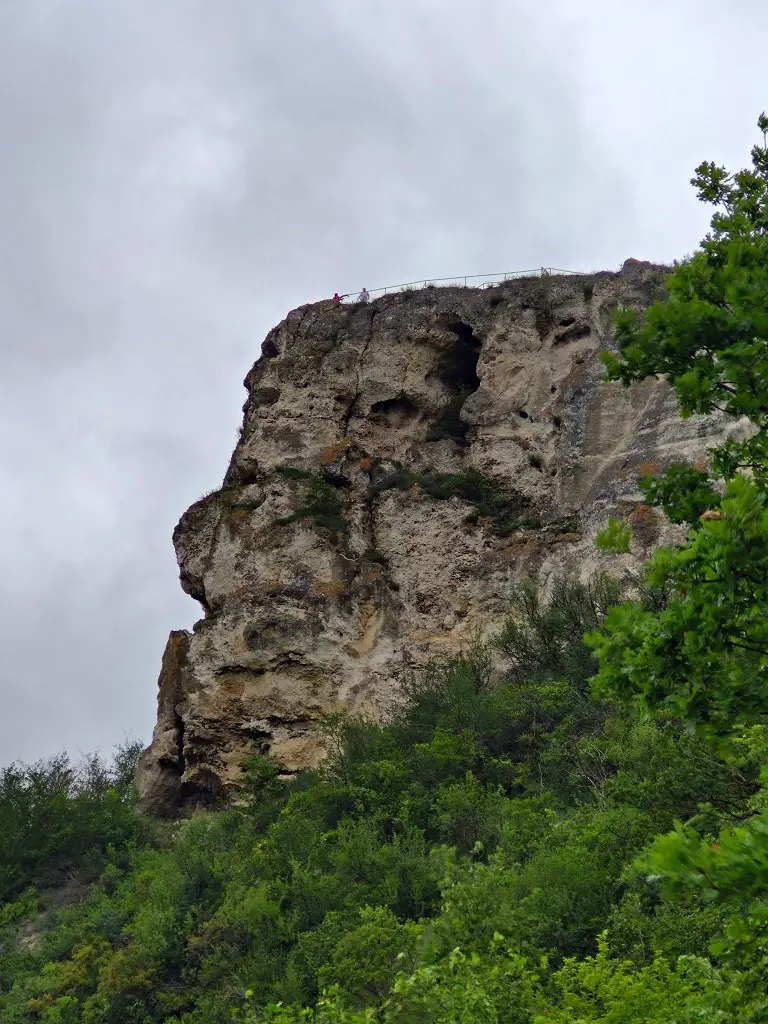
The remains of the cave monastery are located down below. Do not expect long tunnels of caves like at Kyiv-Pechersk Lavra monastery since, as I said before, most of the caves here collapsed into the river. There are basically just three caves (rooms) that are full of icons and church attributes.
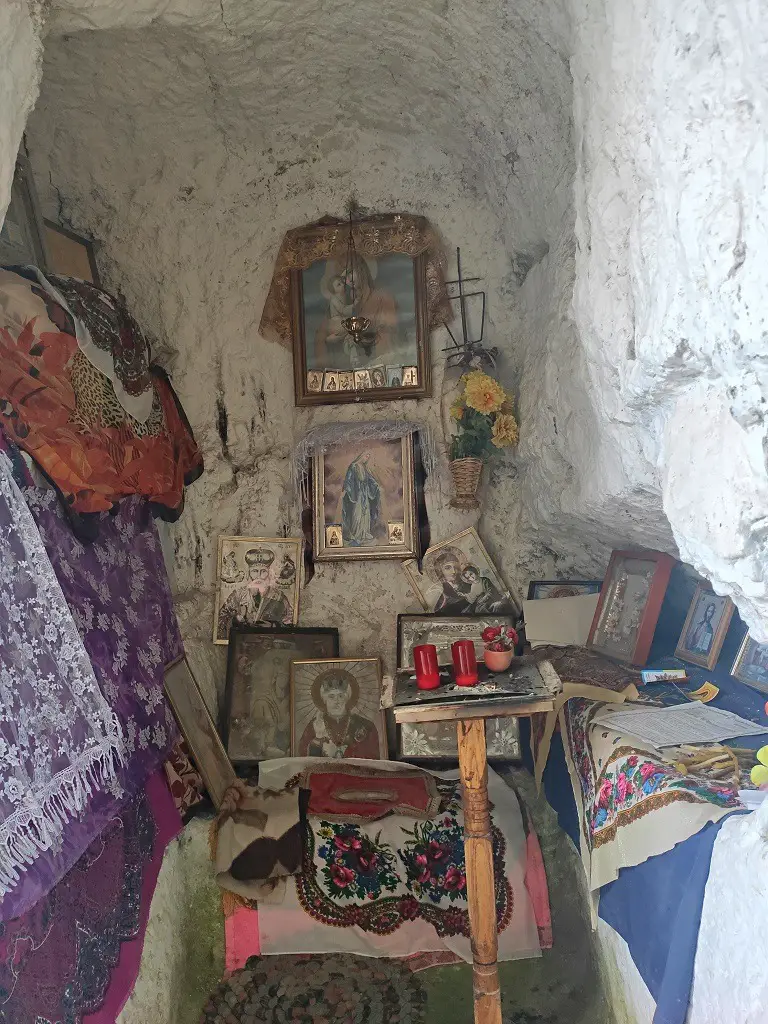
At the bottom of White Rock there is a boat that you can take around the water reservoir. The price will depend on the season and how many people will be in the boat.
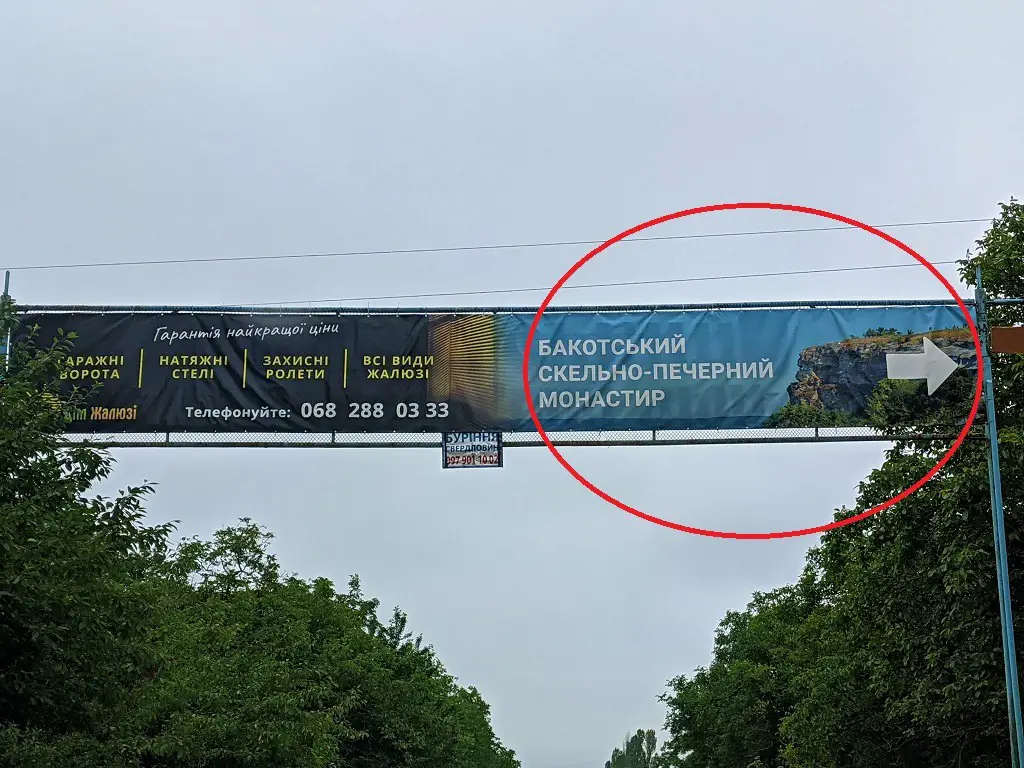
How To Get To The Camping Site
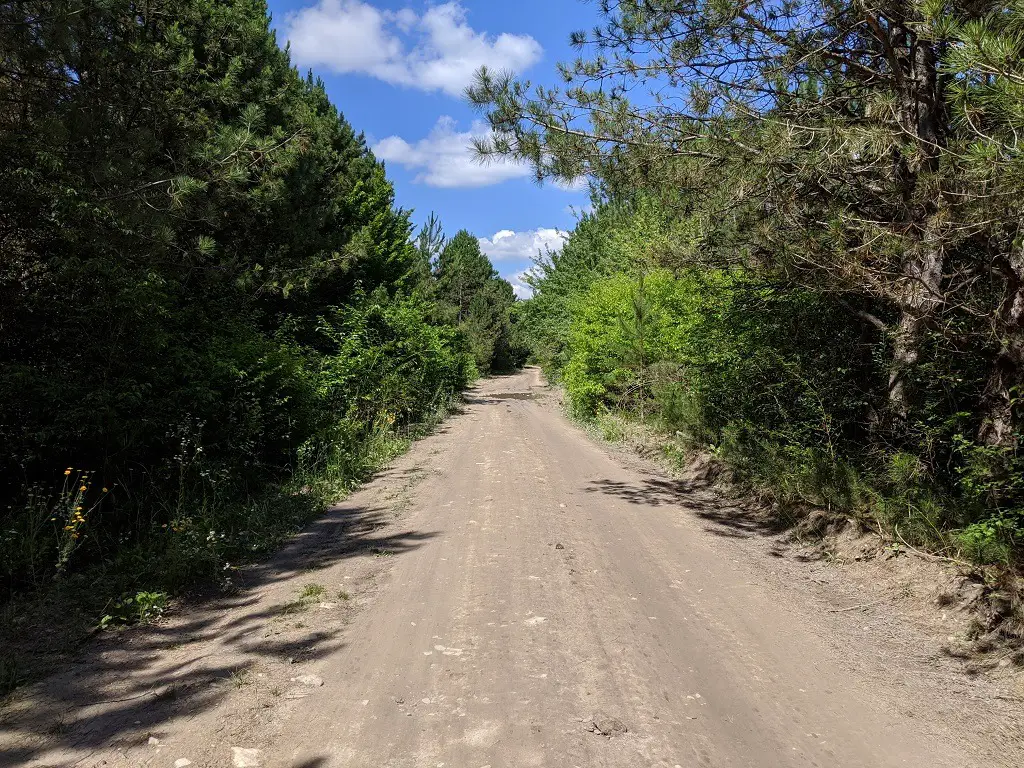
The Bakota camping site is located opposite to White Rock. To get there you will need to drive from the village Hrushka past the village Kashtanivka and through the forest road all the way to the bank of Bakota.
The drive here can be tricky due to the very poor forest road. This road turns into mud during the rain and it is possible you can get stuck somewhere. However we drove after a rainy day and didn’t have too many problems except the car getting dirty.
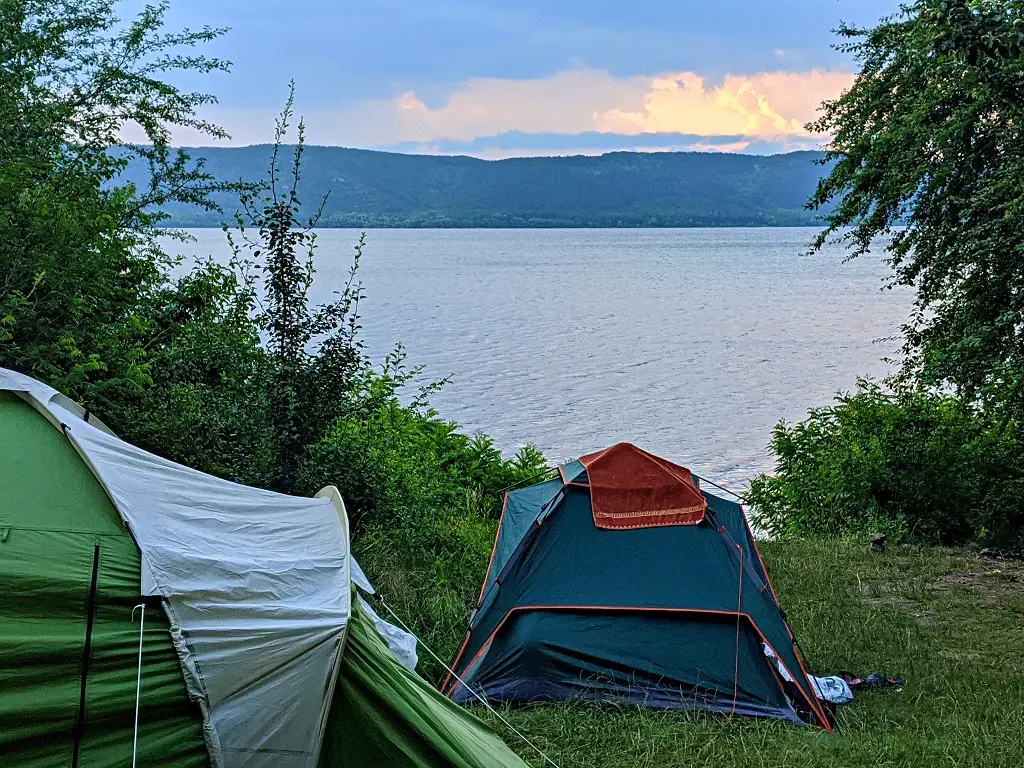
In the middle of your journey through the forest you will get to a fork in the road with a sign that says “Дитячий табір Шанс”. At this sign take a left and follow the road all the way to the next fork. There you will need to take a left again. The road will lead you to the Bakota bank where the camp site is.
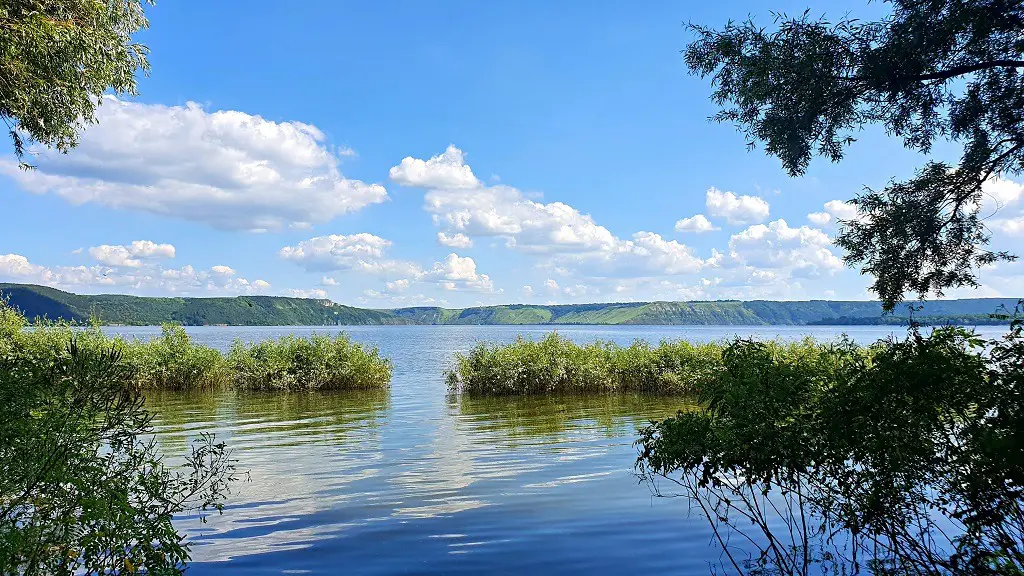
Camping In Bakota
I know what you might expect from a proper camping site and I am telling you that is not what awaits you here. The infrastructure is not developed at this place at all.
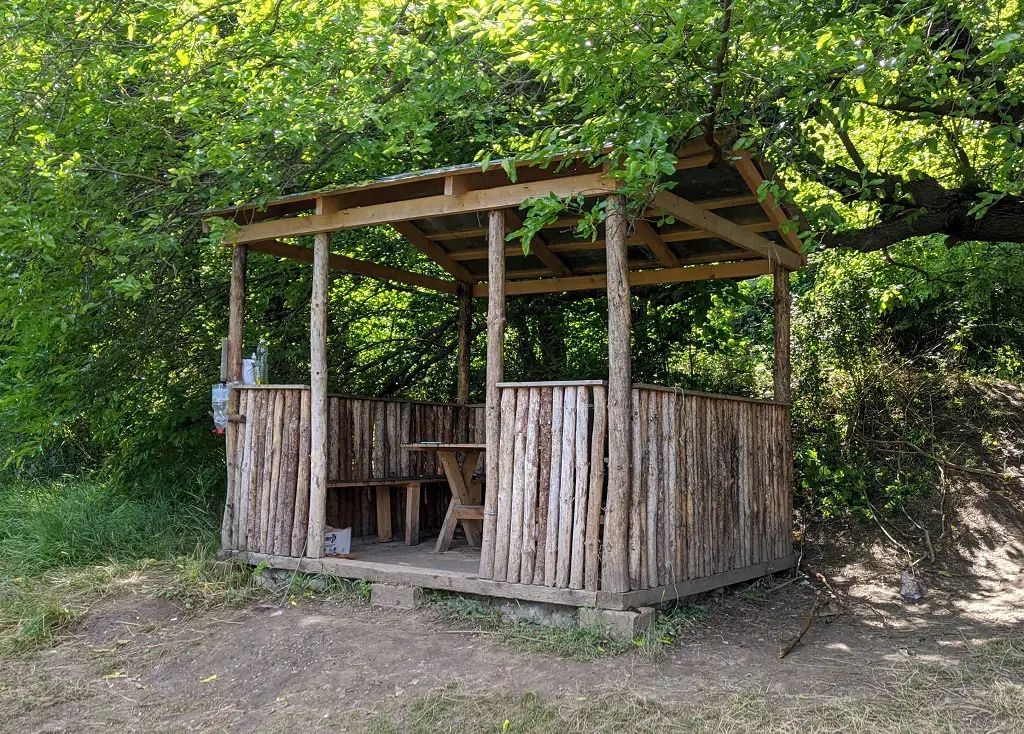
So, what does it mean for you? Well, it means no chargers, no showers, bad phone connection, and most importantly no real toilets. And now I will try to explain everything in the order.
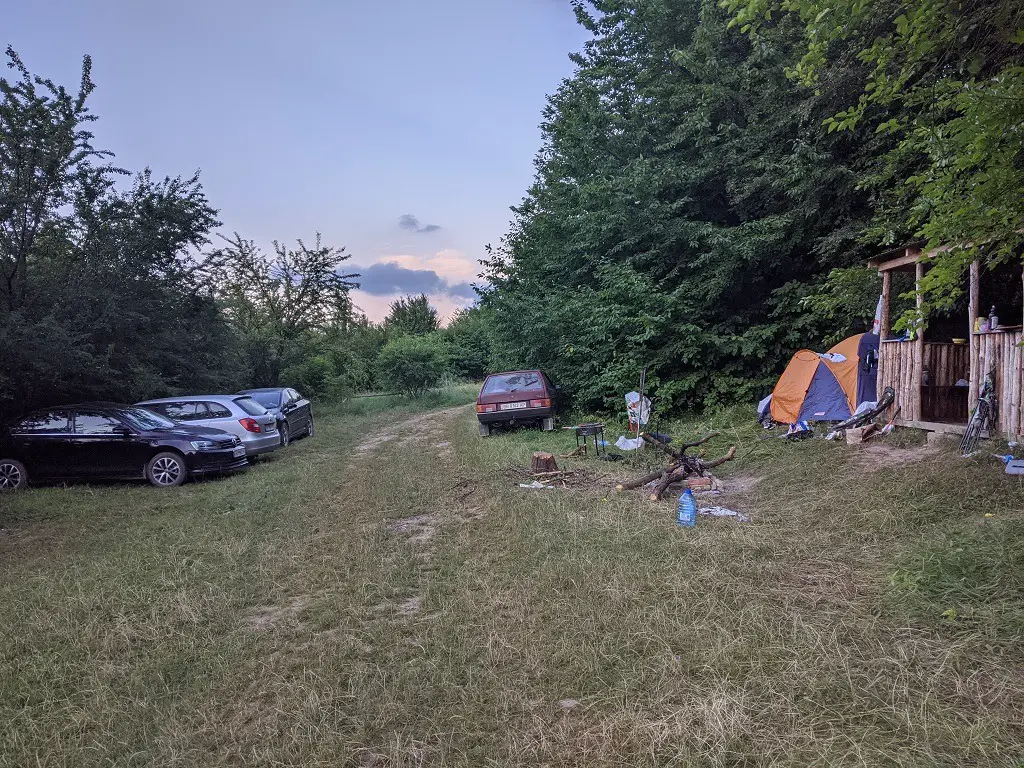
At many popular campgrounds around the world there is usually a clubhouse or an administration building of sorts where you can arrange to rent your spot. At Bakota the campgrounds are just that…ground. Each ‘site’ has a small covered table and a brick firepit, but other than that there are no amenities.
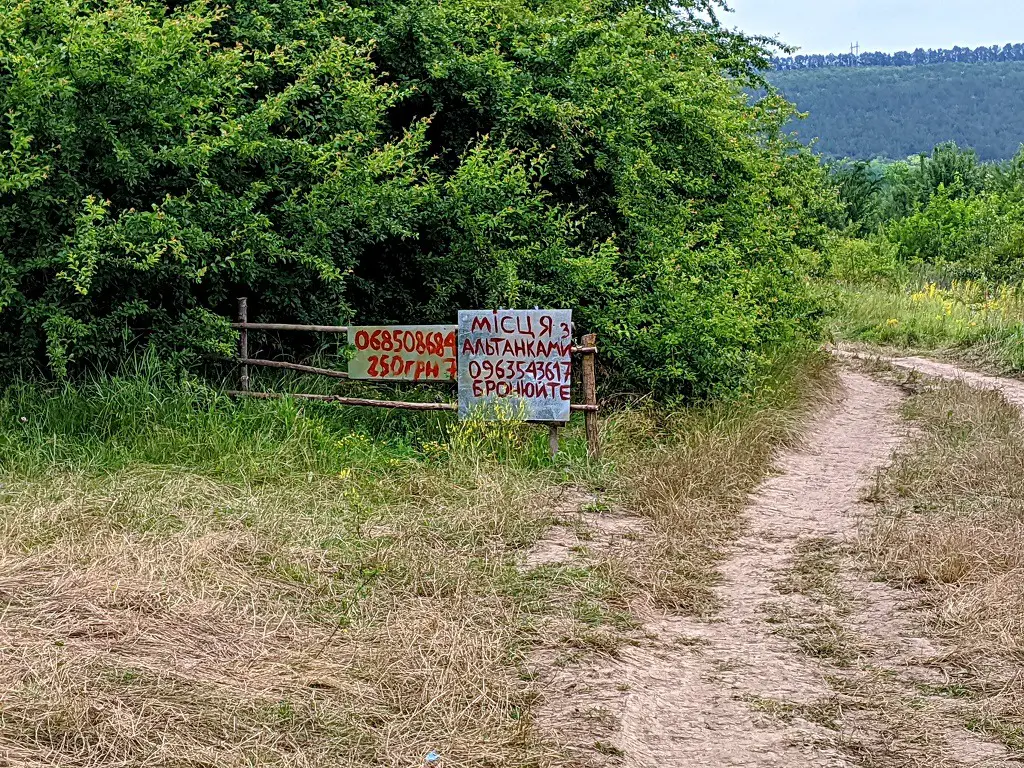
On entering the campground you will see a sign in Ukrainian with a phone number and a price. This says the price for a spot is 250 hryvnia per night and you should call the number to book. I’ll be honest here, we didn’t see the sign at first because it was obscured by a tree branch so we set up our stuff and expected an attendant to show up. Well on our third day someone came and explained how it worked so of course we paid, but they really don’t make it easy to understand how everything works.
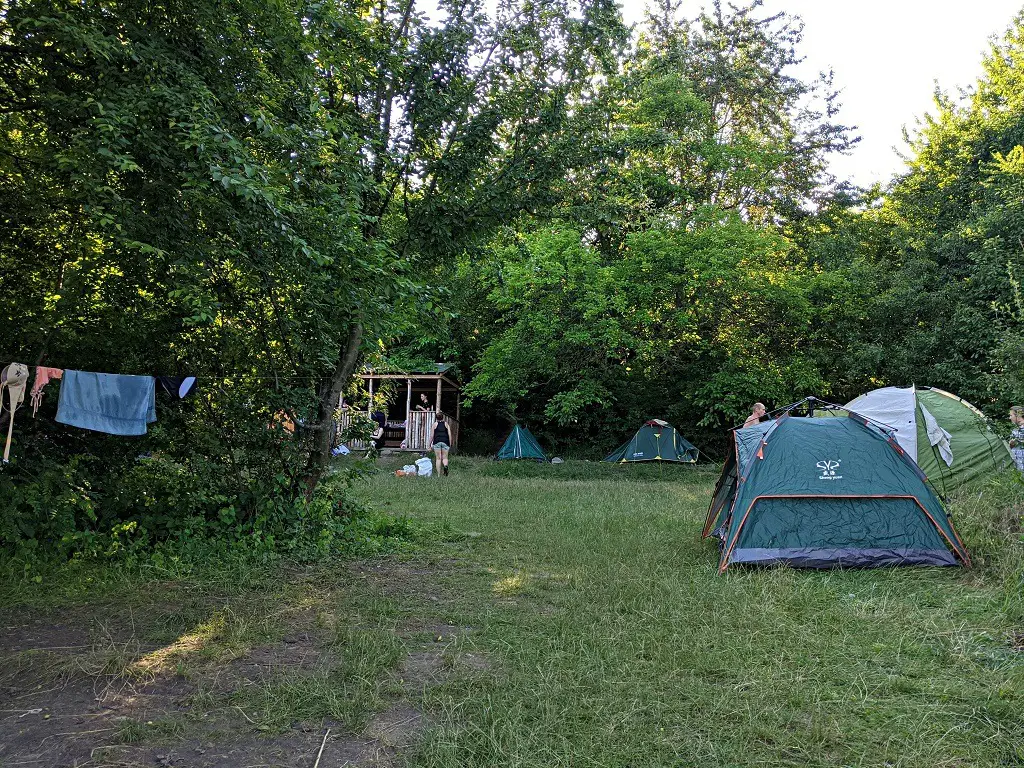
We stayed at site 6 which was large enough to accompany 4 cars and 13 people. After parking we set up our tents and moved all our food under the shade. The great thing many of the spots is they have access right to the water. So, it is easy to go fishing, swimming, or just washing yourself. Since there is no plumbing infrastructure, if you want to stay clean you’ll have to bathe IN Bakota.
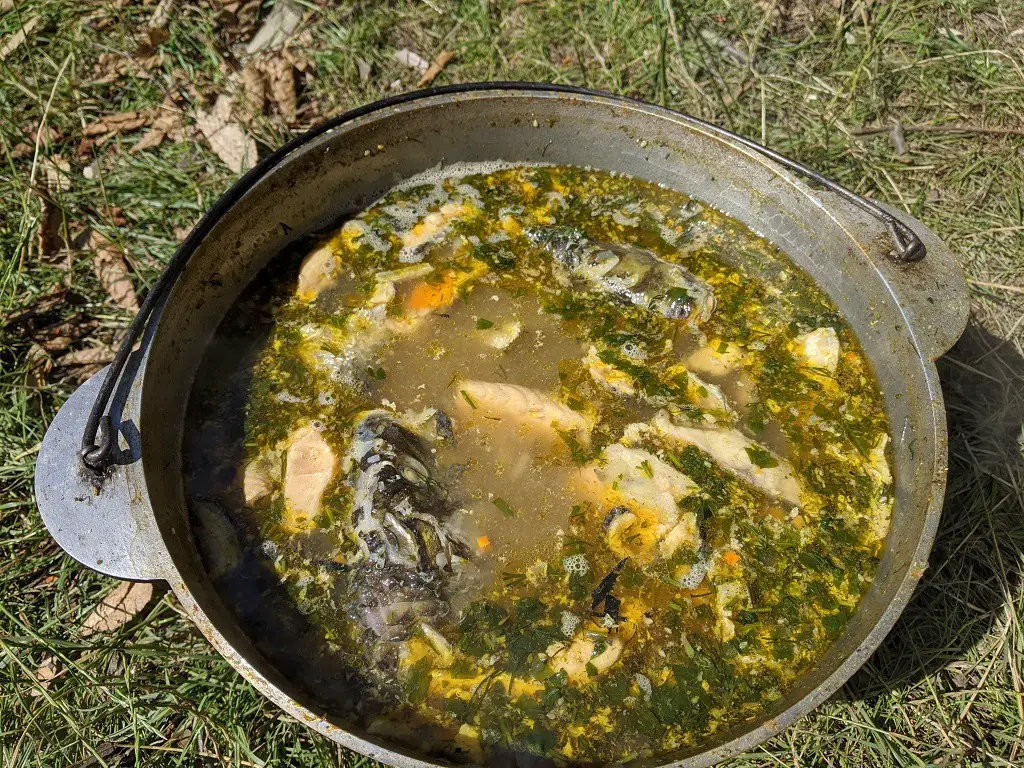
Fish Soup 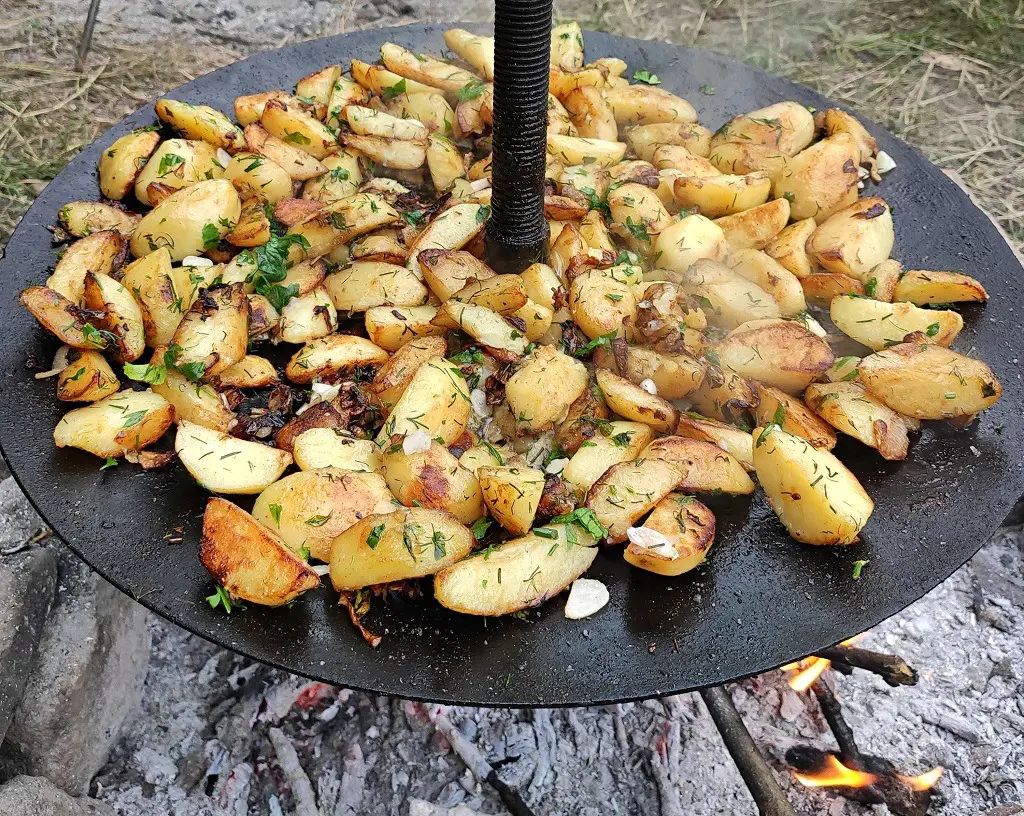
Fried Potatoes
About a kilometre from the entrance of the campsite there is a small beach with a dock for people who want to rent boats to go around the water. Here there is also a bar that sells cold beer and kvass, however they don’t have outlets to charge devices so don’t get your hopes up.
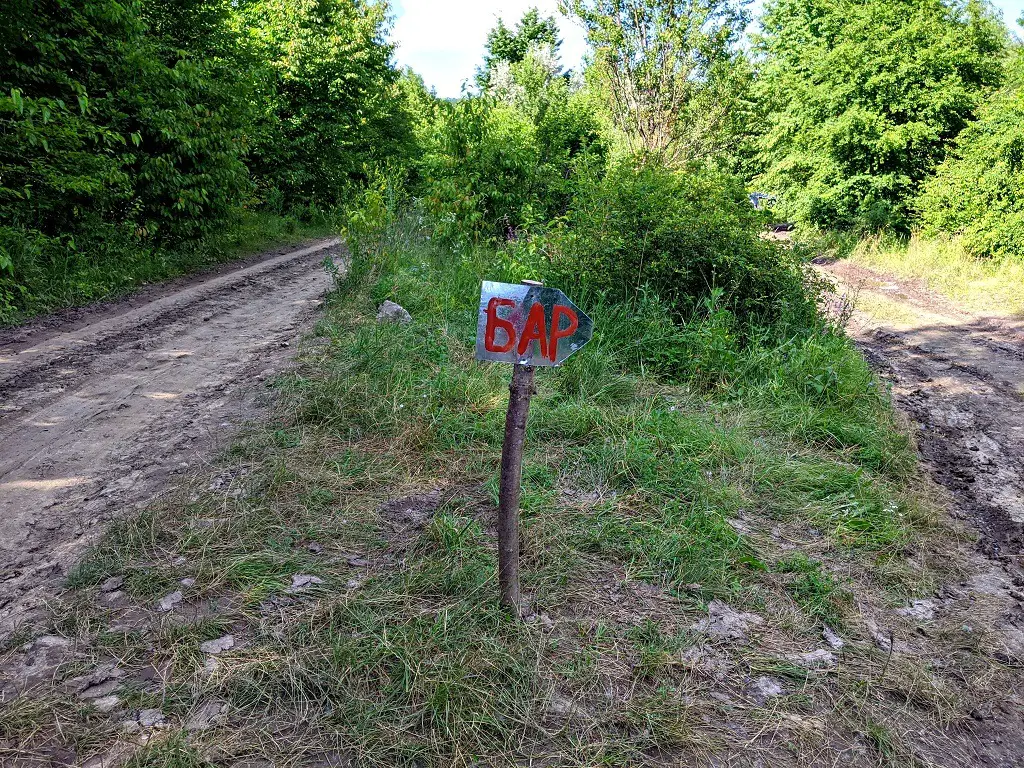
I also mentioned the poor phone connection. We have Lifecell, which is one of the main 3 telecom providers in Ukraine, and had absolutely zero signal the entire time. Some campers had Kyivstar and sometimes had enough signal for phone calls but no internet. No one in our group uses VodafoneUA but I would presume it would also have zero signal.
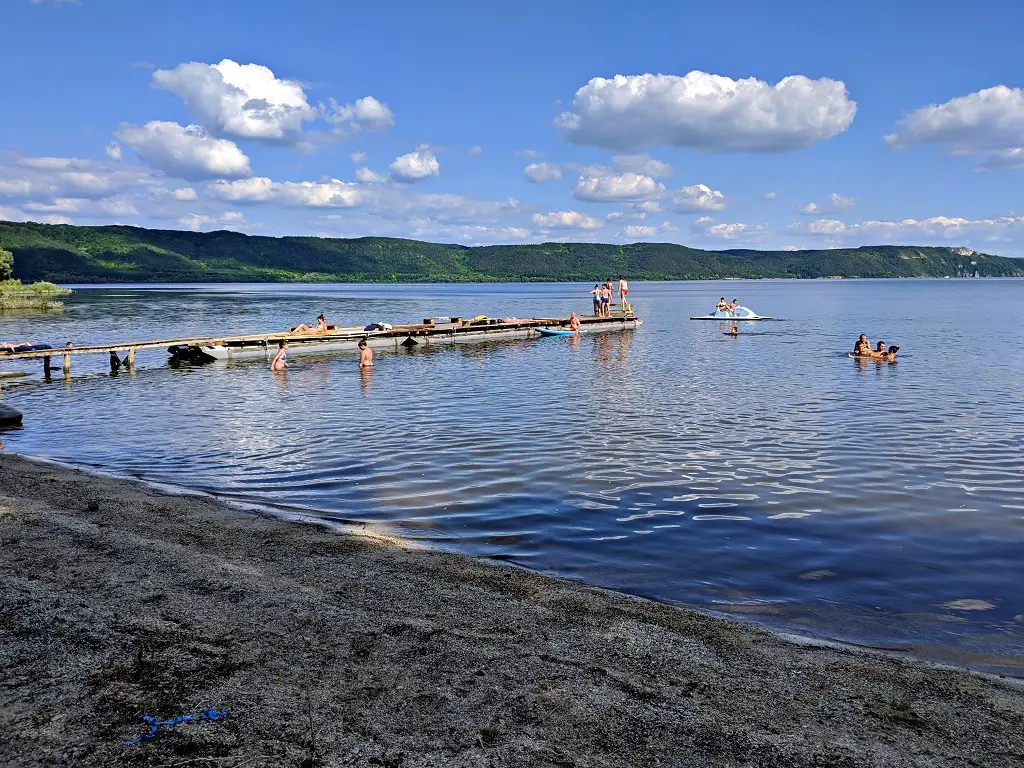
And finally the toilet situation. Well, there is no plumbing so the toilet situation is not pleasant at all. There are technically toilet areas which consist of a hole in the ground bordered by 3 wood plank walls, however more often than not these are completely filthy and/or overflowing. I suggest walking up the mountain a little more and just doing your business in the open (if you walk up high enough there is a near zero chance you’ll see another person).
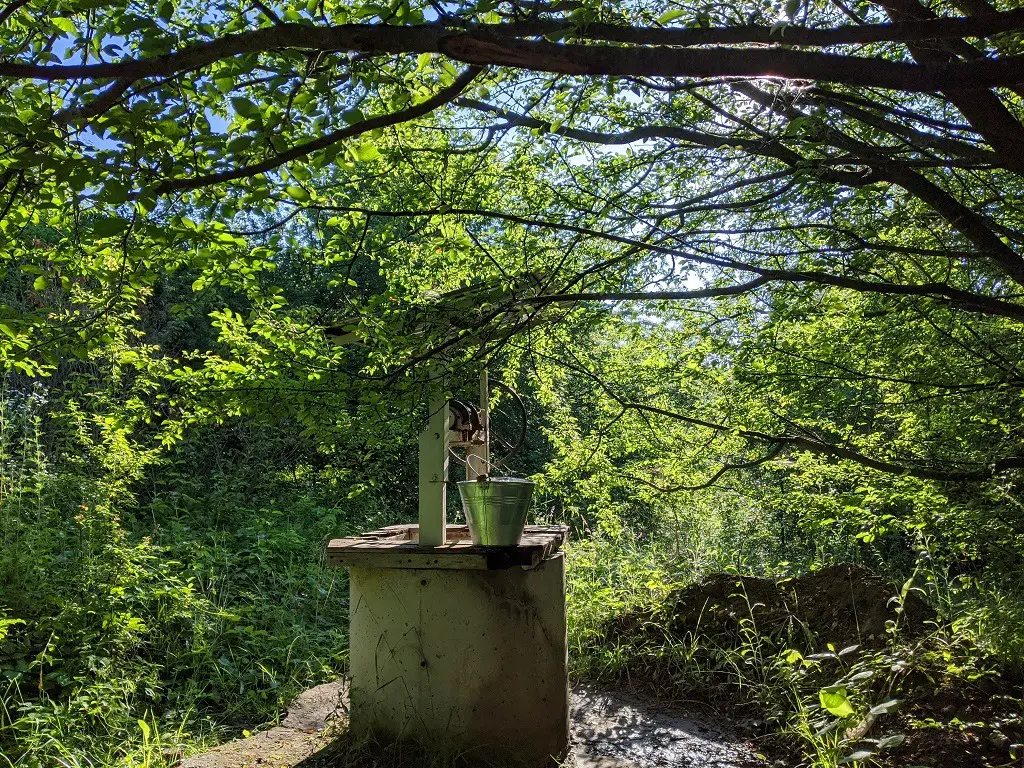
If you do not camp regularly then this bare-bones camping style in Bakota may be difficult, but for experienced campers/hikers then there really isn’t a problem.
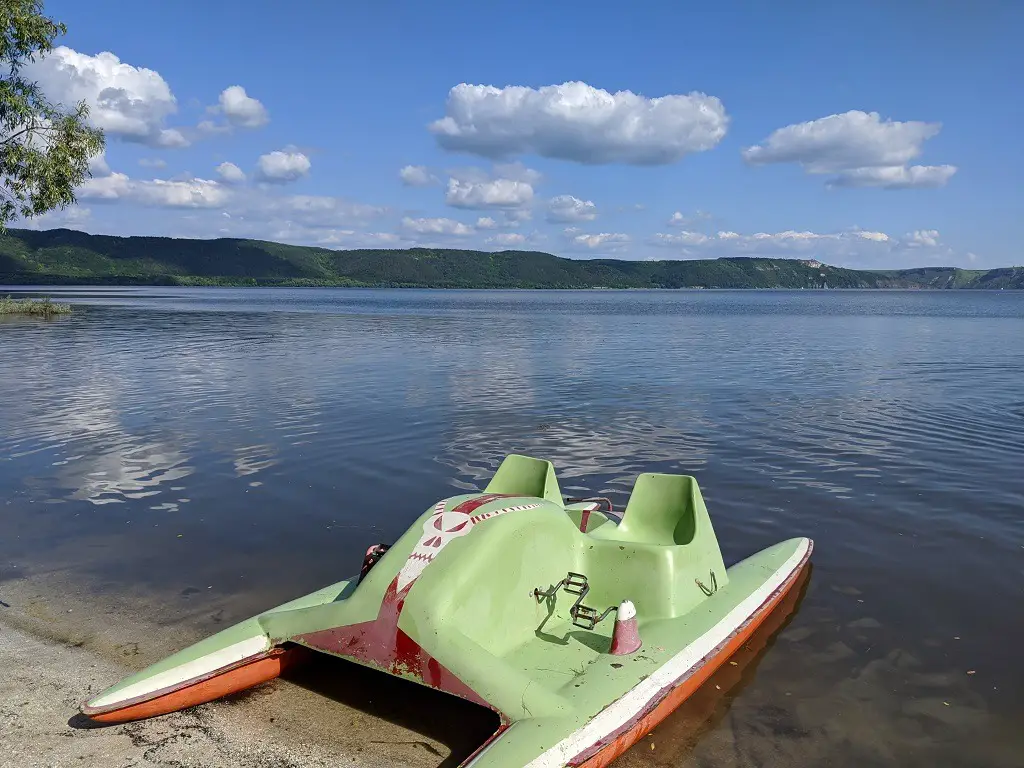
What To Bring For Camping In Bakota
Mandatory Stuff
Tent: We used a cheap $30 pop up tent and it worked just fine. If the weather isn’t expected to storm you just want something to keep the bugs out while you sleep.
Blow Up Mattress / Yoga Mat: We used thick yoga mats under our sleeping bags but some people brought blow up mattresses. The latter were great for creating a makeshift raft on the water or for sun lounging during the day.
Sleeping Bag: The type you’ll need depends on the season you go. My sleeping bag is rated to -5 and Cody’s is to 0 and both were far to warm during the summer nights. I would imagine the case to be quite different if you go in early spring/late fall.
Food: What type of food to bring is up to you. Just make sure to bring enough for however many days you plan to stay there.
Axe: For chopping wood for the fire
Trash Bags: Clean up after yourself. Nature is beautiful because people take away their trash.
Toilet Paper: Okay, this particular trash can stay. Just bring the super cheap paper that dissolves in the rain.
Twine: A big ball of twine is so useful when camping. We used some to make a clothesline to dry our bathing suits and washed clothes, but there are so many uses.
Water Jugs: There is a well a short walk from the campsite with clean fresh water. You can bring water with you but bring it in big jugs so you can refill the jugs later.
Personal Hygiene Products: Self-explanatory.
First Aid Kit: Also self-explanatory, and hopefully not needed.
Warm Clothes: The temperature can change drastically between day and night, and even though it was 30 during the day, we still put on hoodies and sweatshirts at night.
Cooking/Eating Utensils: Normal camp cooking stuff is necessary if you want hot food. I recommend a tripod pot holder with pot, basket grill (grill net), ladle, knife, fork, spoon, bowls/plates, cups, cutting board, napkins/paper towels, dish soap, sponge.
Highly Recommended Stuff
Powerbank: So, you can charge your device the day you leave and have access to that sweet internet.
Mosquito Spray: There are lots of bugs in Bakota…LOTS.
Hat: To protect your head from the sun.
Sunglasses: To make it easier to see, especially since the sun reflects off the water and causes a lot of glare.
Camera: We actually took regular pictures on our phones but brought our drone to get some cool footage. This is up to you since some people do not care about taking pictures.
Sunscreen: If you plan on going out in the water often then sunscreen is a must, otherwise just stay in shaded areas.
Camping In Bakota
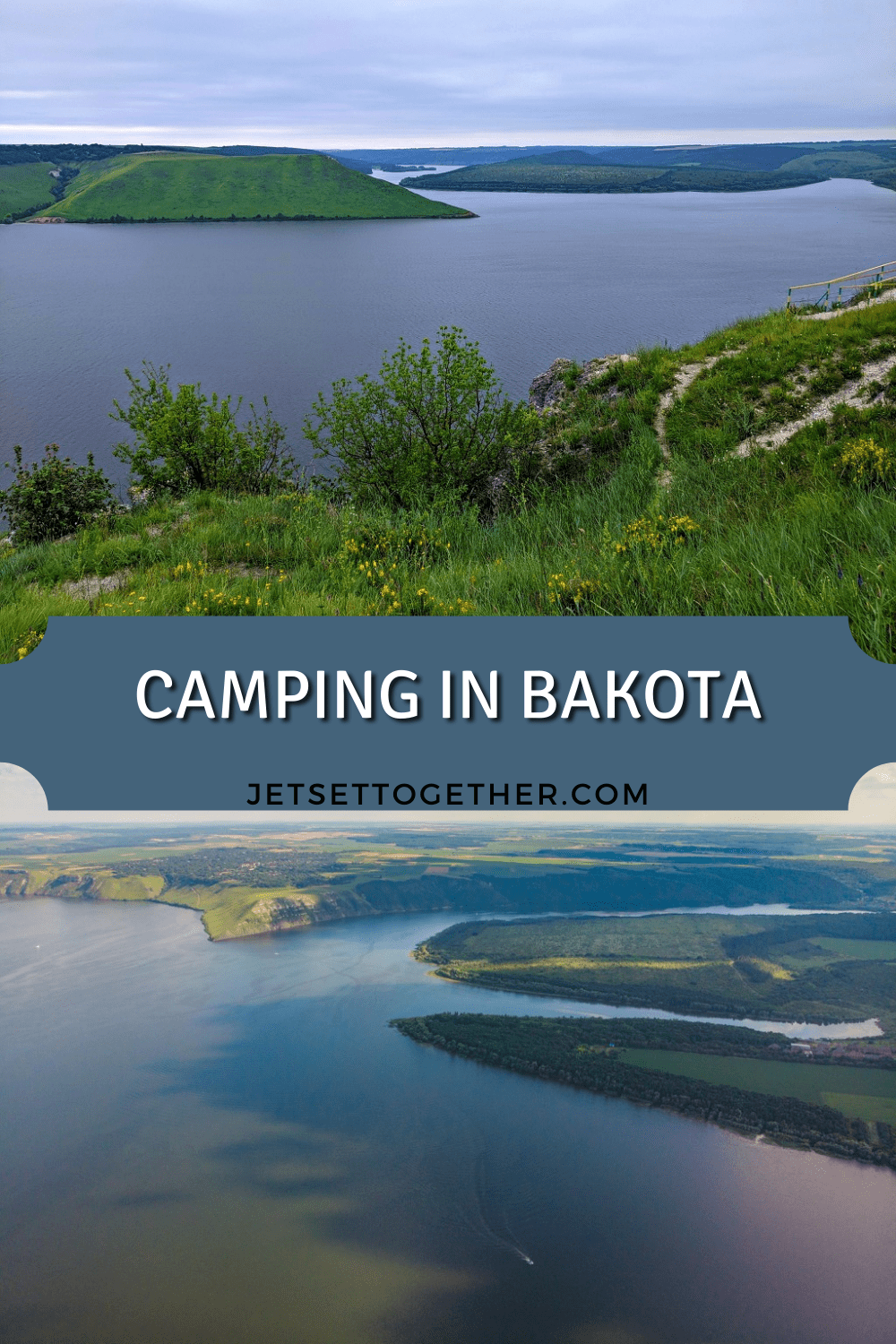
Related Posts
Restaurant Review: Kim Kimchi Korean BBQ in Lviv, Ukraine
Lviv is famous for its culinary scene. Many famous Ukrainian chefs work in this city…
March 15, 2024Restaurant review: Avocado in Lviv, Ukraine
Lviv is known as the cultural capital of Ukraine, but it is so much more…
February 20, 2024

